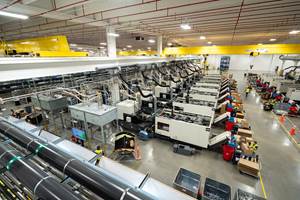On the Cutting Edge of Multi-Shot Molding
Easley Custom Plastics (ECP) Inc. doesn't want to be just your average small to medium-sized custom molder.
Easley Custom Plastics (ECP) Inc. doesn't want to be just your average small to medium-sized custom molder. This $36-million/yr contract molder in Easley, S.C., has just 15 customers and 46 injection presses from 35 to 2200 tons in its 250,000-sq-ft plant. But it runs some 450 active molds and executes from five to eight mold changeovers every shift, says Steven Olson, v.p. of sales and engineering. Easley can perform multi-shot and structural foam molding, gas assist, film insert decorating, assembly, and painting. And now it finds itself on the leading edge of an emerging technology for multi-component molding that has tantalizing potential to perform numerous secondary operations in the mold as well.
ECP is a 35-year-old company that was known as McKechnie Plastic Components until its purchase last year by a South Carolina investment firm. Easley molds parts for building products, heavy trucks, and hand and power tools. Its newest thrust is to expand its capabilities in two-shot molding or overmolding. Previously, ECP had done two-shot molding by transferring the parts robotically or manually from press to press. Now it has found a much better way.
Enter the ‘Cube'
ECP is one of the first few U.S. molders to embrace the "Cube" horizontal rotating stack-mold concept developed by Milacron Inc., Cincinnati, and German moldmaker Foboha GmbH, which has offices in Hamburg, N.J. ECP is also the first U.S. user willing to talk about what it is doing with this technology.
First offered commercially in 2000, the Cube has a turning center stack with four sides between two conventional mold faces. ECP invested $1.3 million for two manufacturing cells that each contain a Ferromatik Milacron K-Tec 450-ton hydraulic press with the Cube technology. Each Cube cell has two injection units of the same size, one in the primary position and the second in the "L" position opposite the operator station. The rotating center stack has 32 cavities on each of its four faces.
The cells are currently dedicated to molding screwdriver handles for Stanley Tools. ECP produces two sizes of handles from yellow polypropylene overmolded with black PP.
Traditional stack molds don't allow for multi-shot molding without transferring parts from one core or cavity to the next. Standard rotary-table technology can automate multi-shot molding, but users have to divide the mold area in half for the first and second shots. So only half of the mold produces a part per cycle.
New rotary stack molds bring together multi-shot capability and a multi-faced tool that utilizes the entire face of the tool for each shot. "Use of the Cube system allows ECP to minimize press size while maximizing product output," says Steve Olson, ECP's v.p. of sales and engineering. "To mold the parts with this many cavities on one machine with conventional technology would require at least a 700-ton press, and possibly one much larger. And the tool would have to be at least 15% larger," notes Olson.
ECP is already starting to think about future purchases of additional rotary-stack molding systems. "The cube system is an excellent selling tool for us," Olson says. "Current and potential customers can see it running and that prompts them to think about what innovative solutions are possible with their product."
Although ECP has not begun to explore the Cube's other capabilities, they were demonstrated at the K 2004 show in Dusseldorf last fall. There, a K-Tec machine ran a commercial European application that involved molding two parts in different colored PP, snap-fitting the two parts together, and applying an adhesive label to the assembly. All of these steps were being performed in each mold cycle.
Related Content
Scaling New Heights With Vertical Integration
Eden Manufacturing was founded on a vision of vertical integration, adding advanced injection molding capabilities to a base of precision moldmaking and more recently bringing Swiss-type machining capabilities in-house.
Read MoreIPEX Opens Injection Molding Facility in North Carolina
The pipe and fittings manufacturer’s new 200,000-square-foot facility represents a $200 million investment and will create 150 jobs.
Read MoreAll-Electric Injection Molding Machine Line Expands
Fakuma 2024: Engel unveils new e-mac 500 with “High” clamping drive and encapsulated toggle-lever mechanism.
Read MoreArburg Open House Emphasizes Turnkey Capabilities
Held at the company’s U.S. headquarters in Rocky Hill, Connecticut, the event featured seven exhibits, including systems that were designed, sourced and built in the U.S.
Read MoreRead Next
For PLASTICS' CEO Seaholm, NPE to Shine Light on Sustainability Successes
With advocacy, communication and sustainability as three main pillars, Seaholm leads a trade association to NPE that ‘is more active today than we have ever been.’
Read MoreLead the Conversation, Change the Conversation
Coverage of single-use plastics can be both misleading and demoralizing. Here are 10 tips for changing the perception of the plastics industry at your company and in your community.
Read More










